History
Establishment in 1913
“... a little enchanted garden of nature; for those who have eyes for the poetry of gardens and picturesque grounds, an intimate fairytale scene in Brandenburg landscape décor, with the queen of flowers at its centre – the rose.” This was the praise from Forst’s local daily newspaper, the ‘Forster Tageblatt’, when the horticultural show and rose exhibition opened back in 1913.
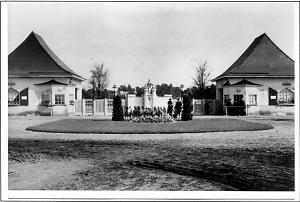
The exhibition was indeed a resounding success: By the time it closed after four months, 350,000 people had visited the exhibition and it was considered superior to the exhibitions held in Wrocław and Leipzig at around the same time.
In October 1913, the town of Forst purchased the rose gardens, thus ensuring their continued existence. In early 1914, the society of German rose enthusiasts (Verein deutscher Rosenfreunde) placed the site under its honorary protection and accorded it the name that it bears to this day: the East German Rose Garden (Ostdeutscher Rosengarten).
Forst’s countless committed inhabitants thus achieved their goal. Paul Engwicht (1876–1947), who owned the local plant nursery and chaired Forst’s society of gardeners and garden enthusiasts (Verein der Gärtner und Gartenfreunde), had been pursuing the idea of creating a permanent rose garden in Forst for several years. In the nineteenth century, roses were a staple in private and public gardens and everyone wanted to join in this trend. The project was finally implemented in the Volkspark created on Weir Island in the south of the town in the early twentieth century. A dry summer in 1911 threatened its existence however, whereupon the town sought the advice of the society of gardeners and garden enthusiasts regarding a solution.
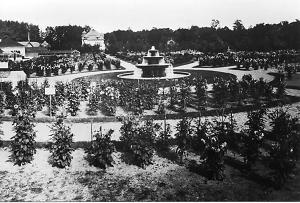
An exhibition manager was appointed. Forst’s new town gardener Alfred Boese (1879–1939), who was responsible for the rose garden until his death, took over management of the exhibition planning.
The exhibition area was divided into two sections, the actual Weir Island and a leased site that lay to its north.
Weir Island Park was laid out in the style of an English landscape garden with ‘natural’ landscaping featuring a network of winding paths and clusters of trees.
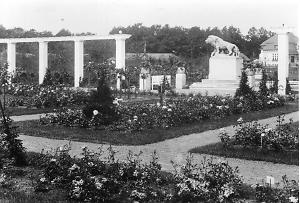
The restaurant on Weir Island was the most important building in the park. For decades, the building with a characteristic half-timbered façade that was already erected back in 1910 remained a popular trip destination. Small rose beds were laid out in a geometric art nouveau style on the leased site to the north of Weir Island (Vorgelände). Model allotment gardens and worker housing show the sociopolitical commitment of the exhibition management and town administration.
Countless garden architecture elements such as sculptures, fountains and pergolas created additional points of interest on the exhibition site. The exhibition programme above all included a large cut flower show, along with countless special shows on everything from beekeeping to gravestone art.
An extensive accompanying programme lent a folk festival feel: It not only included numerous beer tents, kiosks and restaurants, but also an ‘African village’ like the ones popular at human zoos during this time, balloon rides and landing of the ‘Hansa’ zeppelin at the edge of the exhibition site in August 1913.
1913–1945
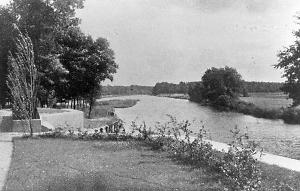
Despite the times of hardship and war, a great deal has survived over the decades from the rose and horticultural exhibition of 1913. Most of the sculptures still exist today, though for conservation reasons, replicas are displayed in the East German Rose Garden these days. The design of the pergolas at the water features and on Weir Island also dates back to the exhibition.
The glamorous start in 1913 came during a dark time: Indeed, things went quiet at the East German Rose Garden during the First World War and the economically difficult years of the Weimar Republic thereafter.
During the war, the site to the north of Weir Island (Vorgelände) was used for farming, later a tree nursery and finally in 1930 an experimental garden. As early as 1923 (the year of hyperinflation) and again in 1927 (the twenty-fifth anniversary of Forst’s society of gardeners and garden enthusiasts), large cut rose and novelty rose shows took place here.
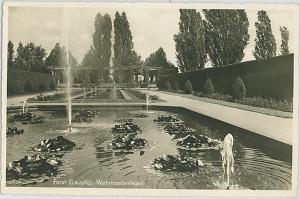
In the late 1920s, the ‘Berliner Rundfunk’ radio broadcaster called the rose garden the “most popular destination for weekend trips”.
The rose garden experienced a second heyday in the 1930s. Following the rose exhibition and laying out of a variety and novelty rose garden in 1933, the highly acclaimed German Rose Show took place here in 1938. It attracted 100,000 visitors. As in 1913, growers from all over Germany exhibited their cut roses during three shows held between July and September. Like the exhibition in 1913, the rose show also included an extensive accompanying cultural programme with concerts and open-air theatre performances. The Rose Garden Festival, which took place from 1939 until well into the war years, was born from this show.
National Socialism left its mark on the rose garden during these years. In 1936, a memorial commemorating Paul von Hindenburg was erected near the pergolas. As Reich President, he has helped Hitler to power by appointing him as Reich Chancellor. In 1943, the memorial was melted down and used for armaments.
1945–1990
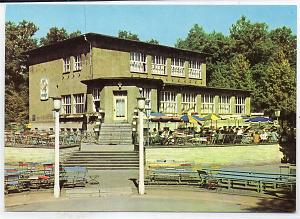
The rose garden was also largely destroyed during the heavy fighting around Forst (Lusatia) in the final months of the Second World War. Due to the widespread hardship, the site was initially used to grow vegetables. Replanting of the rose garden demonstrated the town’s will to assert itself.
With the active involvement of the local population, the restaurant on Weir Island was renovated in 1953 for the celebrations marking the East German Rose Garden’s fortieth anniversary. It was transformed from a ruin to a fully functional restaurant within just a few months.
By the time the Rose Garden Festival opened in 1953, 20,000 roses already once again bloomed here. The festival featuring novelty rose and cut rose shows as well as an extensive cultural programme has been a permanent fixture in Forst’s cultural calendar ever since.
Werner Gottschalk (1920–1995) managed replanting of the rose garden from 1947 up until his retirement in 1985. He transformed it into a park that is today recognised beyond the country’s borders. The replanted rose garden was more generously proportioned than the pre-war garden.
The carefully delimited individual sections and the hedge and poplar boundaries disappeared. The rose plantations have since been concentrated exclusively on the site to the north of Weir Island (Vorgelände), the actual rose garden. A heather garden was added as a new component in 1953. The redesigned Schiller stage, the exhibition hall and the music pavilion also date from the 1950s. Modern sculptures, in particular works by the sculptor Jürgen von Woyski such as the cranes and the wall relief in the experimental garden, were added in the years thereafter. In the post-war decades, the rose garden became one of the most important gardens in Lusatia alongside Pückler’s parks in Branitz and Bad Muskau.
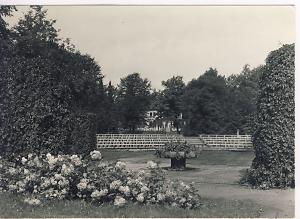
The Rose Garden Festival quickly gained national appeal. Often held in conjunction with other events such as the Workers’ Festival, it attracted more than 100,000 visitors in the 1960s. During the GDR era, the festival lasted around 10 days. Its programme included concerts and theatre performances, sporting competitions and exhibitions, for example by stamp collectors. In the 1980s, ‘The Night of 1,000 Lights’ and the closing event ‘A Bouquet of Roses for ...’ during which the town thanked deserving citizens were also programme fixtures. Numerous other events took place in the time around the festival, such as the company festivals of various companies in Forst.
Forst has elected a Rose Queen every year since 1988.
From 1990
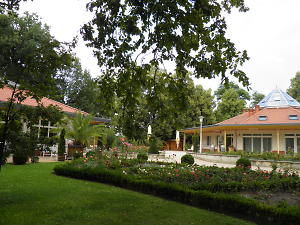
Following the reunification of Germany, the town of Forst (Lusatia) began extensive renovation work in the East German Rose Garden. To mark the 80th anniversary in 1993, the main entrance was recreated according to models from 1913 and the entrance buildings were rebuilt in the same style as the originals that had been destroyed during the war.
Gradual reconstruction of the old fountains and sculptures began in 1994. The traditional restaurant on Weir Island was in such a dire condition that it unfortunately could not be preserved. It was demolished in March 1995. In the years thereafter, the pergolas on Weir Island and the colonnaded avenue leading up to the water feature were renovated so that the East German Rose Garden could be restored to all its former splendour for its ninetieth anniversary in 2003.
The majority of the roses in almost all colours, including green and what are known as black roses, can be found in the Rose Park in an art nouveau style. One highlight – not only for rose lovers – is the novelty rose garden featuring roses from the best-known German and international rose schools.
Rose lovers are able to gain inspiration for their gardens at home, for what grows in Lusatia certainly has a good chance of growing well in other regions, too. Memories of a rose-filled idyll on the River Neisse.
Weir Island Park in an English style is perfect for leisurely strolls. Historically, it is the origin of the present-day park. As the name suggests, it was created by altering the course of the River Neisse and building weirs. Rosenflair restaurant is also located here and Sleeping Beauty Playground is very popular among young visitors.
The East German Rose Garden is not just a paradise for rose lovers though: At the end of summer, for example, an explosion of dahlias can be enjoyed. For over 60 different varieties have been incorporated into the summer plantings. What’s more, themed gardens make a visit worthwhile at any time of year – from spring to autumn. The accessible park is open all year round, whereby admission fees only apply at certain times of the year.
Centenary celebrations
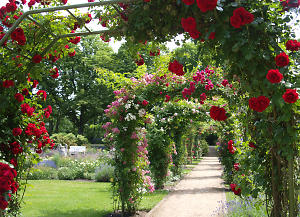
In 2013, a new garden was created to mark the centenary of the East German Rose Garden. Several rose varieties have been blended with modern perennial plantings in this anniversary garden. In 2013, a replica of the cascade fountain popular among visitors to Weir Island in 1913 was also installed in close consultation with the monument protection authorities. Burbling water is an indispensable feature of any paradisical rose garden – and the restored water features at the centre of the garden offer just this with their various fountains and jets. All visitors to the Rose Garden should definitely linger here until they have discovered their own personal favourite among the sea of roses. For there are countless colours, fragrances and shapes to choose from that climb, creep, cascade or form arches, grow as bushes, or are formed into balls or grown as standard roses.


